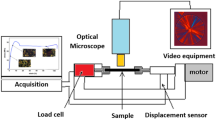Abstract
The chain regularity of isotactic polypropylene (iPP) homopolymer and random copolymers was characterized by different thermal fractionation methods in this study. Different stepwise temperature programs were applied in a calorimeter (DSC), in order to develop a method which is significantly faster than stepwise isothermal segregation technique (SIST) and provides reliable information about the chain regularity of iPP. Our studies prove that self-seeding accelerates the crystallization process during annealing in SSA–DSC experiments (successive self-nucleation and annealing). Consequently, the time of isothermal steps can be shortened significantly in the SSA–DSC method. On the other hand, we found that step time should not be too short if the goal of the measurement is the determination of average chain regularity. Our results clearly indicate that both the experimental conditions and the evaluation technique influence the obtained results. A standard experimental procedure is proposed for reliably determining the average chain regularity of iPP. The length of the SSA–DSC temperature program developed in this study is much shorter compared to that of the conventional SIST measurements used recently for such experiments. The proposed SSA–DSC program makes the reliable characterization of a large number of samples on an acceptable timescale possible.














Similar content being viewed by others
References
Varga J, Menczel J, Solti A. The melting of high-pressure polyethylene subjected to stepwise heat-treatment. J Therm Anal. 1979;17:333–42.
Gahleitner M, Severn JR. Designing polymer properties. In: Severn JR, Chadwick JC, editors. Tailor-made polymers via immobilization of alpha-olefin polymerization catalysts. Weinheim: Wiley VCH; 2008.
Muller AJ, Arnal ML. Thermal fractionation of polymers. Prog Polym Sci. 2005;30:559–603.
Gray AP, Casey K. Thermal analysis and the influence of thermal history on polymer fusion curves. J Polym Sci B Polym Phys. 1964;2:381–8.
Varga J, Menczel J, Solti A. Memory effect of low-density polyethylene crystallized in a stepwise manner. J Therm Anal. 1976;10:433–40.
Shanks R, Amarasinghe G. Comonomer distribution in polyethylenes analysed by DSC after thermal fractionation. J Therm Anal Calorim. 2000;59:471–82.
Chen F, Shanks RA, Amarasinghe G. Crystallisation of single-site polyethylene blends investigated by thermal fractionation techniques. Polymer. 2001;42:4579–87.
Liu TM, Harrison IR. A DSC method of measuring short-chain branching distribution in linear low-density polyethylene. Thermochim Acta. 1994;233:167–71.
Matsko M, Vanina M, Echevskaya L, Zakharov V. Study of the compositional heterogeneity of ethylene–hexene-1 copolymers by thermal fractionation technique by means of differential scanning calorimetry. J Therm Anal Calorim. 2013;113:923–32.
Virkkunen V, Laari P, Pitkänen P, Sundholm F. Tacticity distribution of isotactic polypropylene prepared with heterogeneous Ziegler–Natta catalyst. 1. Fractionation of polypropylene. Polymer. 2004;45:3091–8.
Virkkunen V, Laari P, Pitkanen P, Sundholm F. Tacticity distribution of isotactic polypropylene prepared with heterogeneous Ziegler–Natta catalyst. 2. Application and analysis of SSA data for polypropylene. Polymer. 2004;45:4623–31.
Garoff T, Virkkunen V, Jääskeläinen P, Vestberg T. A qualitative model for polymerisation of propylene with a MgCl2-supported TiCl4 Ziegler–Natta catalyst. Eur Polym J. 2003;39:1679–85.
Gahleitner M, Jaaskelainen P, Ratajski E, Paulik C, Reussner J, Wolfschwenger J, Neissl W. Propylene-ethylene random copolymers: comonomer effects on crystallinity and application properties. J Appl Polym Sci. 2005;95:1073–81.
Bai F, Li F, Calhoun BH, Quirk RP and Cheng SZD. Physical constants of poly(propylene). In: Brandrup J, Immergut EH, Grulke EA, editors. Polymer handbook. New Jersey: Wiley; 1999, 1:V/21–30.
Phillips P, J. and Mezghani K. Polypropylene, isotactic (polymorphism). In: Salamon JC, editor. The polymeric materials encyclopedy. Boca Raton: CRC Press; 1996, 9: 6637–49.
Chang H, Ren S, Dang X, Zhang L, Li H, Hu Y. The effect of the mixed external donors on the sequence length distribution of polypropylene. J Appl Polym Sci. 2012;. doi:10.1002/app.38762.
Kang J, Yang F, Wu T, Li HL, Cao Y, Xiang M. Polymerization control and fast characterization of the stereo-defect distribution of heterogeneous Ziegler–Natta isotactic polypropylene. Eur Polym J. 2012;48:425–34.
Lorenzo AT, Arnal ML, Sanchez JJ, Muller AJ. Effect of annealing time on the self-nucleation behavior of semicrystalline polymers. J Polym Sci Part B Polym Phys. 2006;44:1738–50.
Grein C, Gahleitner M, Knogler B, Nestelberger S. Melt viscosity effects in ethylene-propylene copolymers. Rheol Acta. 2007;46:1083–9.
Bafna SS. Is the cross-over modulus a reliable measure of polymeric polydispersity? J Appl Polym Sci. 1997;63:111–3.
Moore EP, editor. Polypropylene handbook: polymerization, characterization, properties, processing, applications. Cincinnati: Hanser-Gardner Publications; 1996.
Varga J. Crystallization, melting and supermolecular structure of isotactic polypropylene. In: Karger-Kocsis J, editor. Polypropylene: structure, blends and composites. London: Chapmann&Hall; 1995. 1: 56–115.
Padden FJ, Keith HD. Spherulitic crystallization in polypropylene. J Appl Phys. 1959;30:1479–84.
Horváth Z, Sajó IE, Klaus S, Menyhárd A, Varga J. The effect of molecular mass on the polymorphism and crystalline structure of isotactic polypropylene. Express Polym Lett. 2010;4:101–14.
Varga J. Melting memory effect of the beta-modification of polypropylene. J Therm Anal. 1986;31:165–72.
Varga J. Supermolecular structure of isotactic polypropylene. J Mater Sci. 1992;27:2557–79.
Monasse B, Haudin JM. Growth transition and morphology change in polypropylene. Colloid Polym Sci. 1985;263:822–31.
Clark EJ, Hoffman JD. Regime-III crystallization in polypropylene. Macromolecules. 1984;17:878–85.
Horváth Z, Menyhárd A, Doshev P, Gahleitner M, Tranninger C, Kheirandish S, Varga J, Pukánszky B. Effect of molecular architecture on the crystalline structure and stiffness of iPP homopolymers: modeling based on annealing experiments. J Appl Polym Sci. 2013;130:3365–73.
Acknowledgements
One of the Authors (Alfréd Menyhárd) would like to express his gratitude to the János Bolyai Research Scholarship of the Hungarian Academy of Sciences. In addition, the Authors acknowledge for the financial support of the National Scientific Research Fund of Hungary (OTKA Grant No K101124 and PD 109346) for their projects on the structure–property correlations of polymeric materials. The Authors are grateful to Matthew Parkinson and Andreas Albrecht of Borealis Linz for the 13C-NMR measurements and the TREF fractionation, respectively.
Author information
Authors and Affiliations
Corresponding author
Rights and permissions
About this article
Cite this article
Horváth, Z., Menyhárd, A., Doshev, P. et al. Chain regularity of isotactic polypropylene determined by different thermal fractionation methods. J Therm Anal Calorim 118, 235–245 (2014). https://doi.org/10.1007/s10973-014-3999-5
Received:
Accepted:
Published:
Issue Date:
DOI: https://doi.org/10.1007/s10973-014-3999-5




